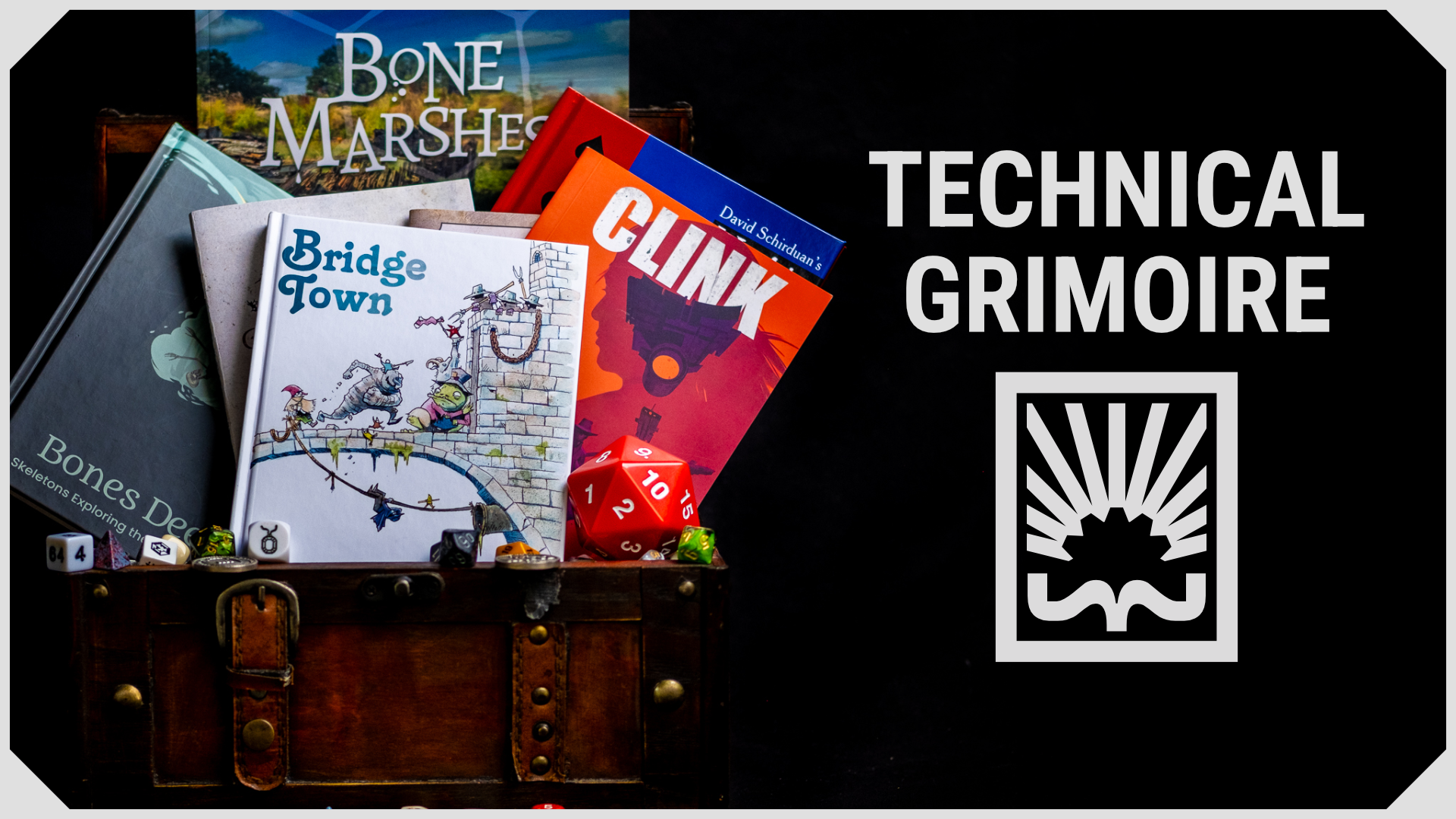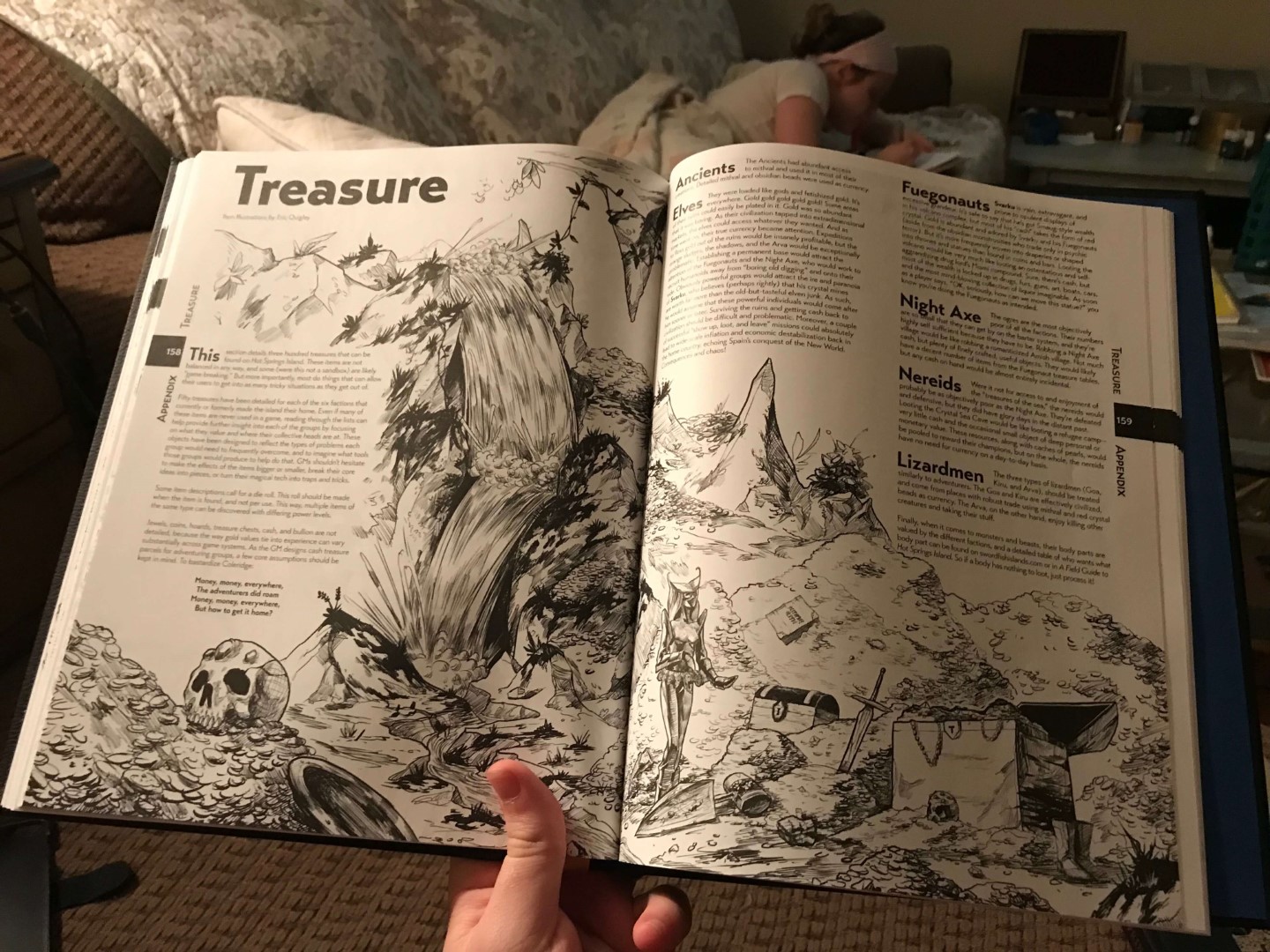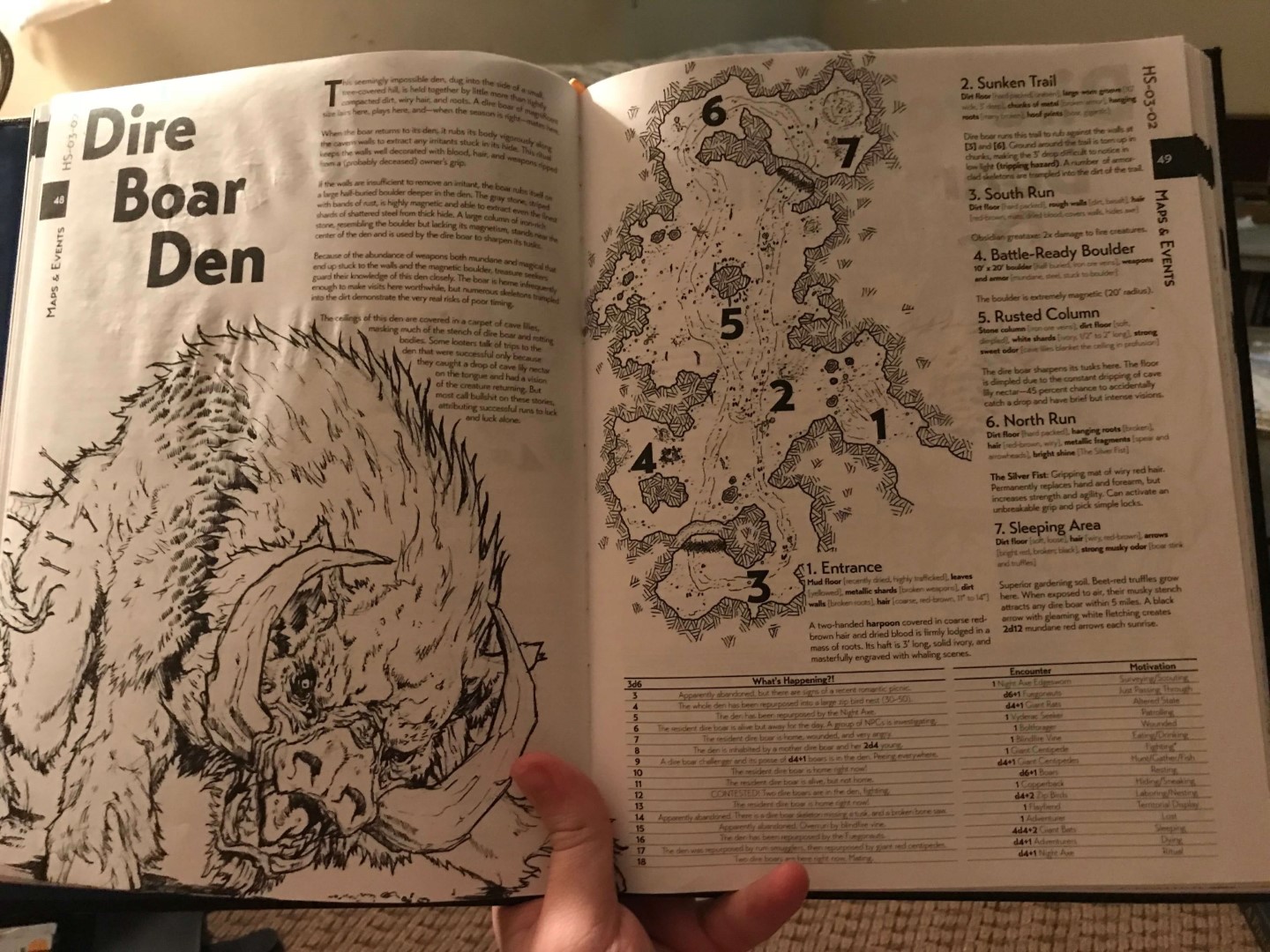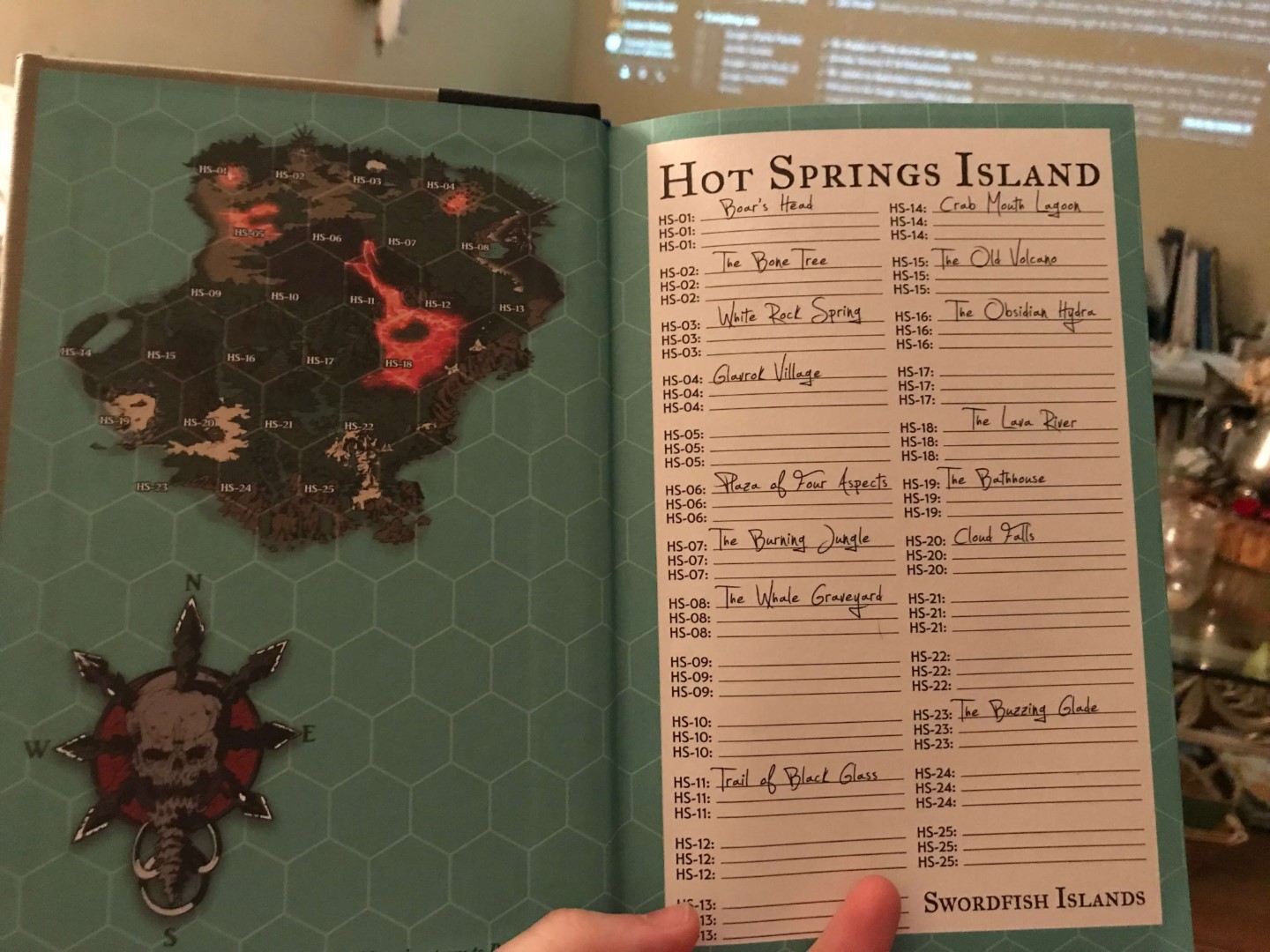Hot Springs Island is ALIVE!

Hot Springs Island, a new adventure from Jacob Hurst, is alive.
I don’t mean the books are alive, although they look sharp enough to cut somebody. I mean the fictional island feels like a living, breathing, screaming place. There are adventures out there with better stories, more interesting puzzles, or stranger creatures. But no adventure bleeds like Hot Springs Island.
I whipped up a reference sheet for this awesome setting. Grab it here! Permalink
And I made a mobile-friendly generator! Permalink
Looking at the two books above you might ask: “Which one is the adventure?” And the answer is both. They are both the adventure.
The large black one is for the GM. It contains charts, details, and secrets about the island. The smaller book is for the players; a guidebook, bestiary, and quest board. You don’t need the player book to experience the adventure, but you’ll be missing out on what brings this island to life.
In fact I can think of three ways that Jacob Hurst brings Hot Springs Island to life.
1) Three 6-Sided Dice Permalink
Random encounters are a staple of tabletop rpgs, and at first glance Hot Springs sticks to the usual tricks, albeit with a really nice layout for easy access. But the secret is how all the tables are rolled: Three 6-sided dice. Not a d20.
This means that some encounters are much more likely to occur than others. Some encounters are “Normal”. If something is Normal, it can be learned and explored.
You know that this area usually is filled with snakes or hawks. But sometimes it might have an elemental. Rarely you’ll come across a wounded lizardman.
It feels like you’re discovering and learning your way around a real place. Real places can be somewhat predictable, but might surprise you from time to time. The more time players spend in an area, the better they know it, and the more real it seems to them.
What’s truly incredible is that this regular schedule comes at no cost to the GM. They don’t need to track patterns, habits, or creature percentages for each area. Just roll on the tables and the probability will take care of the rest!
Hot Springs takes this concept even further with location events. Whenever players enter a location the GM rolls on a table to see what’s happening there. It’s different every time, but thanks to 3d6, there are common occurances.
Let’s use my favorite example: The Dire Boar. The Dire Boar is a huge school-bus sized monster that can trample elephants. There are a few places on the island where it can be a rare encounter. But it does have a home; a den on the island adventurers might stumble across.
Now in another adventure, the Dire Boar is always home and provides a scary boss fight for anyone who enters the cave. But on Hot Springs there are a bunch of possibilities. Maybe the Dire Boar isn’t home, but will be later. Maybe there are TWO dire boars fighting for control of the den. Maybe another group of adventurers just finished killing it. Or my favorite: just the ancient skeleton remains.
If the adventurers decide to return here in a few sessions, the GM just rolls on the table and works the result into the story. There used to be a skeleton here, but now 4 “teenage” dire boars are living here: children of the ancient monster.
I cannot stress how easily these tables bring everything to life. And with little to no effort on the part of the GM, who also enjoys the surprising table results.
2) Information Access Permalink
Hot Springs is meant to be referenced on the fly, right there at the table. When I first received the book I dreaded my first read; making extensive notes and references so I could easily find what I needed.
By the end of my first read, I had a page or two of notes. Anything I needed was already in a reference, or included in multiple places throughout the book. It’s hard to explain without showing all the pages here. You’ll just have to believe me when I say that everything is perfectly placed for easy access at the table. I might flip to another page every hour or so, if that.
Having all the answers and secrets at my fingertips really helps the island come to life at the table. Here’s a great post going into more detail about the layout and presentation.
3) The Player Guidebook Permalink
Whew. Originally this article was JUST going to be about the player book. But after ranting and raving for pages and pages I had to cut it down. I wasn’t really explaining how well the book brings the island to life. I was just praising the idea and implementation. So let me try a better way:
Example 1: Glorp Schlop Permalink
“You hear a low GLORP sound coming from the treeline. A gooey imitation of a person stands before you, covered in a strange orange goop that bubbles and slurps everywhere.” At this point the players immediately grab the guidebook and start flipping through it.
The players think they’ve found it and begin reading the information. Goopy, check. Humanoid, check. 3 feet tall….wait, how tall is it? “6 feet”, the GM responds. Crap! This isn’t it at all! Players continue hunting through the book for a better match. Even though the game has technically stopped, the players are having a blast reading about the different creatures.
Example 2: Whoop Whoop Permalink
“You hear a loud WOOOP WOOOP WOOP coming from behind this door, as well as the ruffling of some feathers.” The players look through the book and find an entry for the Zip Bird. They read about how the birds can run quickly and make strange wooping noises. But then the ranger reads this:
“Rumor: Some say that Zip Birds can be domesticated into better hunters than dogs.”
The players immediately start planning the capture of one of these creatures.
Keep in mind the GM book doesn’t say anything about domesticating Zip Birds. The player book also admits that much of the information is hearsay and may be utterly false. The GM can either roll with it, or allow the players to be mislead by a false rumor from the book. Both choices have merit; but as a GM, I prefer to drive home how the guidebook sometimes lies.
A useful but flawed reference for the players to read through helps bring the island to life. It feels like a real place with a crappy travel guide included. Not only is it a fun way to learn about the island, but it also removes yet another burden from the GM: exposition.
ProTip: Keep notes about descriptions of the creatures. When the book says, “There are 4 Vyderac here”, don’t tell that to the players, but describe the strange insectoid creatures to them. Let them look through the book and learn for themselves.
Conclusion Permalink
There are adventures with better stories, more interesting puzzles, or stranger creatures. But no other book, setting, or module feels as alive as Hot Springs Island. If your group wants to explore a place that feels real and fantastic at the same time, they should board the nearest vessel to Hot Springs Island.





